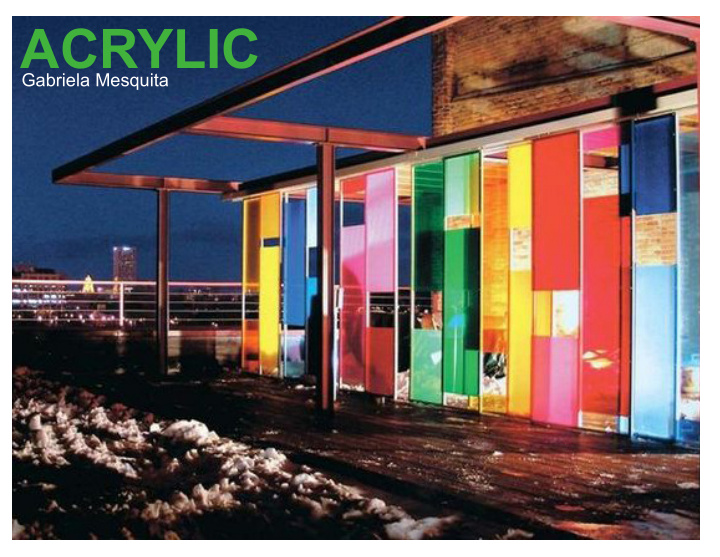



ACRYLIC Gabriela Mesquita
what is ACRYLIC ? Acrylic plastic : family of synthetic (man-made) plastic materials containing one or more derivatives of acrylic acid Most common acrylic plastic= polymethyl methacrylate (PMMA) sold as Plexiglas, Lucite, Perspex, and Crystallite PMMA is a tough, highly transparent, and light thermoplastic material with excellent chemical and weathering resistance; good alternative for glass colorfast and non-yellowing good structural and thermal properties, dimensionally stable can be colored, molded, cut, drilled, and formed can become brittle and tends to scratch more than glass
Each acrylic strand contains a seed in its tip. All the seeds used were found within 185 miles of the site. Inspired by crops blowing in the wind, the rods are free to sway gently with the wind. SEED CATHEDRAL Location: UK Pavilion at Shanghai Expo Date: 2010 Designer: Heatherwick Studio
1877 who invented ACRYLIC ? polymerization process to turn methyl methacrylate into polymethyl methacrylate (PMMA) discovered by German chemists Fittig and Paul 1928 acrylic plastic was fjrst produced 1933 brought to market by Rohm and Haas Company
All acrylics are constructed from petroleum distillates that are reacted to give acrylic acid. Methyl methacrylate is basic molecule from which acrylic plastic is formed. Acrylic plastic forms when methyl methacrylate is reacted with a catalyst (usually organic peroxide). Like other plastics, they are polymers , meaning they are made up of many molecules, or parts, linked together like a chain Acrylic can be formed in fmat sheets (most common), rods and tubes , or into a molding powder . PMMA can be joined using cyanoacrylate cement (superglue) , with heat (welding) , or by using solvents such as di- or trichloromethane to dissolve the plastic at the joint, which then fuses and sets, forming an almost invisible weld. where does it come FROM ?
PMMA is a thermoplastic, meaning it has higher impact strength, is easier to process, and is more adaptable to complex designs. It is able to soften when heated and hardens as it cools. what is it used FOR ? First applications were in World War II when it was used for submarine periscopes as well as airplane windows, turrets, and canopies. Ideal for applications such as skylights, automobile taillights, outdoor signs, lenses, acrylic nails, paint, security barriers, medical devices, and LCD screens. Due to clarity, also often used for windows, tanks, and enclosures around exhibits. In interior spaces , can be used for furniture, decorative vases, trays, or walls.
what are the ENVIRONMENTAL IMPACTS ? Manufacturing involves highly toxic substances and produces toxic fumes Recent legislation requires polymerization process to be done in closed environment and that fumes be cleaned, captured, or neutralized before discharge to the atmosphere Not easily recycled - a group 7 plastic and is not collected for recycling in most communities Not readily biodegradable Large pieces can be reformed into other useful objects if not severely damaged Does not contain or release BPA and is not toxic in solid form
Average annual increase in rate of consumption: 10% Future annual growth rate of 5% is predicted Continual innovate use of acrylic plastic in design and art installations Lucite International currently in the process of developing a plant that will use the Alpha process, which is a cheaper, greener way of making methyl methacrylate what are the FUTURE USES ?
RESOURCES https://en.wikipedia.org/wiki/Poly(methyl_ methacrylate) https://en.wikipedia.org/wiki/Wilhelm_Rudolph_ Fittig http://www.madehow.com/Volume-2/Acrylic- Plastic.html https://www.creativemechanisms.com/blog/ injection-mold-3d-print-cnc-acrylic-plastic-pmma http://sumitomo-chem.com.sg/pmma/science- lesson-4-acrylic-plastic-made/ https://www.ingenia.org.uk/Ingenia/ Articles/3ab65b97-7930-452a-b3a3- bbd5147f41a4
Recommend
More recommend